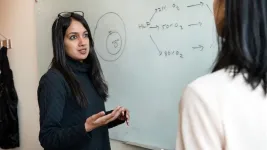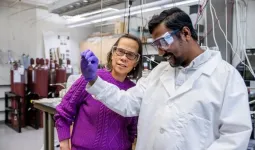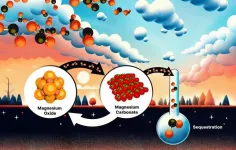(Press-News.org) A University of Iowa-led team of international neuroscientists have obtained the first direct recordings of the human brain in the minutes before and after a brain hub crucial for language meaning was surgically disconnected. The results reveal the importance of brain hubs in neural networks and the remarkable way in which the human brain attempts to compensate when a hub is lost, with immediacy not previously observed.
Hubs are critical for connectivity
Hubs are everywhere. The hub of a bicycle wheel, with spokes shooting out from the center, keeps the wheel from collapsing when the bicycle is ridden. Airport hubs connect cities across the world. And social hubs like coffee shops or online social networks are places people gather for interaction.
The human brain has hubs, too – the intersection of many neuronal pathways that help coordinate brain activity required for complex functions like understanding and responding to speech. However, whether highly interconnected brain hubs are irreplaceable for certain brain functions has been controversial. By some accounts the brain, as an already highly interconnected neural network, can in principle immediately compensate for the loss of a hub, in the same way that traffic can be redirected around a blocked off city center.
With a rare experimental opportunity, the UI neurosurgical and research teams led by Matthew Howard III, MD, professor and DEO of neurosurgery, and Christopher Petkov, PhD, professor and vice chair for research in neurosurgery, have achieved a breakthrough in understanding the necessity of a single hub. By obtaining evidence for what happens when a hub required for language meaning is lost, the researchers showed both the intrinsic importance of the hub as well as the remarkable and rapid ability of the brain to adapt and at least partially attempt to immediately compensate for its loss. The findings were reported recently in the journal Nature Communications.
Evaluating the impact of losing a brain hub
The study was conducted during surgical treatment of two patients with epilepsy. Both patients were undergoing procedures that required surgical removal of the anterior temporal lobe—a brain hub for language meaning—to allow the neurosurgeons access to a deeper brain area causing the patients’ debilitating epileptic seizures. Before this type of surgery, neurosurgery teams often ask the patients to conduct speech and language tasks in the operating room as the team uses implanted electrodes to record activity from parts of the brain close to and distant from the planned surgery area. These recordings help the clinical team effectively treat the seizures while limiting the impact of the surgery on the patient’s speech and language abilities.
Typically, the recording electrodes are not needed after the surgical resection procedure and are removed. The innovation in this study was that the neurosurgery team was able to safely complete the procedure with the recording electrodes left in place or replaced to the same location after the procedure. This made it possible to obtain rare pre- and post-operative recordings allowing the researchers to evaluate signals from brain areas far away from the hub, including speech and language areas distant from the surgery site. Analysis of the change in responses to speech sounds before and after the loss of the hub revealed a rapid disruption of signaling and subsequent partial compensation of the broader brain network.
“The rapid impact on the speech and language processing regions well removed from the surgical treatment site was surprising, but what was even more surprising was how the brain was working to compensate, albeit incompletely within this short timeframe,” says Petkov, who also holds an appointment at Newcastle University Medical School in the UK.
The findings disprove theories challenging the necessity of specific brain hubs by showing that the hub was important to maintain normal brain processing in language.
“Neurosurgical treatment and new technologies continue to improve the treatment options provided to patients,” says Howard, who also is a member of the Iowa Neuroscience Institute. “Research such as this underscores the importance of safely obtaining and comparing electrical recordings pre and post operatively, particularly when a brain hub might be affected.”
According to the researchers, the observation on the nature of the immediate impact on a neural network and its rapid attempt to compensate provides evidence in support of a brain theory proposed by Professor Karl Friston at University College London, which posits that any self-organizing system at equilibrium works towards orderliness by minimizing its free energy, a resistance of the universal tendency towards disorder. These neurobiological results following human brain hub disconnection were consistent with several predictions of this and related neurobiological theories, showing how the brain works to try to regain order after the loss of one of its hubs.
In addition to Petkov and Howard, the research team included researchers in the UI Departments of Neurosurgery, Radiology, and Psychological and Brain Sciences, as well as colleagues from Newcastle University, UCL, and University of Cambridge in the UK, and from Carnegie Mellon University, University of Wisconsin-Madison, and Gonzaga University in the United States.
The research was funded in part by grants from National Institutes of Health, the Wellcome Trust. and the European Research Council.
END
What happens when the brain loses a hub?
Rare experiment during brain surgery helps researchers better understand neural networks
2023-12-08
ELSE PRESS RELEASES FROM THIS DATE:
Study reveals Zika’s shape-shifting machinery—and a possible vulnerability
2023-12-08
Viruses have limited genetic material—and few proteins—so all the pieces must work extra hard. Zika is a great example; the virus only produces 10 proteins. Now, in a study published in the journal PLOS Pathogens, researchers at Sanford Burnham Prebys have shown how the virus does so much with so little and may have identified a therapeutic vulnerability.
In the study, the research team showed that Zika’s enzyme—NS2B-NS3—is a multipurpose tool with two essential functions: breaking up proteins (a protease) and dividing its own double-stranded RNA into single strands (a helicase).
“We found that Zika’s ...
RIT leading STEM co-mentoring network
2023-12-08
Two Rochester Institute of Technology professors are leading a National Science Foundation-funded project to support minoritized women students in STEM through a co-mentoring network called WiSEN (Women in STEM Network).
Betsy Dell, professor in the College of Engineering Technology, and Makini Beck, assistant professor in the College of Liberal Arts and the School of Individualized Study, have teamed up with Washington State University, Gonzaga University, and the University of Montana to use nearly $600,000 awarded by the NSF to create a network model to connect women STEM students. Sarah Bark was recently hired to be the project manager. She will support the daily operations and ensure ...
Genetic mutations that promote reproduction tend to shorten human lifespan, study shows
2023-12-08
A University of Michigan-led study based on a review of genetic and health information from more than 276,000 people finds strong support for a decades-old evolutionary theory that sought to explain aging and senescence.
In 1957, evolutionary biologist George Williams proposed that genetic mutations that contribute to aging could be favored by natural selection if they are advantageous early in life in promoting earlier reproduction or the production of more offspring. Williams was an assistant professor at Michigan State University at ...
CAMH develops potential new drug treatment for multiple sclerosis
2023-12-08
December 8, 2023 (Toronto) – CAMH-led pre-clinical studies using a small molecule drug have shown promise as a potential new treatment for multiple sclerosis (MS). The results have been published today in the journal Science Advances.
Expanding on Dr. Fang Liu’s earlier work that identified a novel drug target for the treatment of MS, she and her team have now created a small molecule compound that is effective in two different animal models of MS. This represents a key advancement that brings this MS research closer to the clinic to impact patient care.
MS is a progressive neurological ...
Polyethylene waste could be a thing of the past
2023-12-08
An international team of experts undertaking fundamental research has developed a way of using polyethylene waste (PE) as a feedstock and converted it into valuable chemicals, via light-driven photocatalysis.
The University of Adelaide’s Professor Shizhang Qiao, Chair of Nanotechnology, and Director, Centre for Materials in Energy and Catalysis, at the School of Chemical Engineering, led the team which published their findings in the journal Science Advances.
“We have upcycled polyethylene plastic waste into ethylene and propionic acid with high selectivity using atomically dispersed metal catalysts,” said Professor Qiao.
“An oxidation-coupled ...
A dynamic picture of how we respond to high or low oxygen levels
2023-12-08
SAN FRANCISCO—December 8, 2023—It only takes holding your breath for slightly too long to understand that too little oxygen is bad for you. But can you also have too much? Indeed, breathing air with a higher oxygen level than your body needs can cause health problems or even death.
But with scant research on the topic, scientists have known little about how the body senses too much oxygen. Now, a new study from Gladstone Institutes has greatly expanded the scientific body of knowledge about the mechanisms at play, and why it matters for health.
Their findings, reported in the journal Science Advances, explain how breathing air with different levels of ...
University of Toronto researchers discover new lipid nanoparticle that shows muscle-specific mRNA delivery, reduces off-target effects.
2023-12-08
TORONTO – A team of researchers based at the University of Toronto’s (U of T) Leslie Dan Faculty of Pharmacy has discovered a novel ionizable lipid nanoparticle that enables muscle-focused mRNA delivery while minimizing off-target delivery to other tissues. The team also showed that mRNA delivered by the lipid nanoparticles investigated in their study triggered potent cellular-level immune responses as a proof-of-concept melanoma cancer vaccine.
The study, led by Bowen Li, assistant professor, Leslie Dan Faculty of Pharmacy, U ...
Evolving insights in blood-based liquid biopsies for prostate cancer interrogation
2023-12-08
“In the United States, 288,300 new cases of prostate cancer are estimated for 2023 [...]”
BUFFALO, NY- December 8, 2023 – A new research perspective was published in Oncoscience (Volume 10) on November 30, 2023, entitled, “Evolving insights in blood-based liquid biopsies for prostate cancer interrogation.”
During the last decade, blood sampling of cancer patients aimed at analyzing the presence of cells, membrane-bound vesicles, or molecules released by primary tumors or metastatic growths emerged as an alternative to traditional tissue biopsies. The advent of this minimally invasive approach, known as blood-based liquid biopsy, ...
Finding the most heat-resistant substances ever made
2023-12-08
The most durable, heat-resistant materials ever made could be hiding in plain sight.
The U.S. Department of Defense wants to know if minerals and rocks found on Earth and in space hold the secrets of next-generation high-temperature materials. To find out, the DOD awarded $6.25 million through its Multidisciplinary University Research Initiative, or MURI, to a team from the University of Virginia and Arizona State University. The group is led by UVA’s Elizabeth J. Opila, the Rolls-Royce Commonwealth Professor and chair of the Department of Materials Science and Engineering.
The ...
Time-tested magnesium oxide: Unveiling CO2 absorption dynamics
2023-12-08
Magnesium oxide is a promising material for capturing carbon dioxide directly from the atmosphere and injecting it deep underground to limit the effects of climate change. But making the method economical will require discovering the speed at which carbon dioxide is absorbed and how environmental conditions affect the chemical reactions involved.
Scientists at the Department of Energy’s Oak Ridge National Laboratory analyzed a set of magnesium oxide crystal samples exposed to the atmosphere for decades, and another for days to months, to gauge the reaction rates. They found that carbon ...
LAST 30 PRESS RELEASES:
Optimized kinetic pathways of active hydrogen generation at Cu2O/Cu heterojunction interfaces to enhance nitrate electroreduction to ammonia
New design playbook could unlock next generation high energy lithium ion batteries
Drones reveal how feral horse units keep boundaries
New AI tool removes bottleneck in animal movement analysis
Bubble netting knowledge spread by immigrant humpback whales
Discovery of bats remarkable navigation strategy revealed in new study
Urban tributaries identified as major sources of plastic chemical pollution in the Yangtze River
UK glaucoma cases higher than expected and projected to reach 1.6 million+ by 2060
Type 2 diabetes prevention could more than halve carbon footprint linked to disease complications
Over 1 million estimated to have glaucoma in UK
Early treatment can delay rheumatoid arthritis for years
National childhood type 1 diabetes screening is effective and could prevent thousands of emergency diagnoses, UK study shows
Mix of different types of physical activity may be best for longer life
Continuous care from community-based midwives reduces risk of preterm birth by 45%
Otago experts propose fiber as first new essential nutrient in 50 years
Auburn Physics PhD student earns prestigious DOE Fellowship
AI tool helps you learn how autistic communication works
To show LGBTQ+ support, look beyond Pride Month
Using artificial intelligence to understand how emotions are formed
Exposure to wildfire smoke late in pregnancy may raise autism risk in children
Breaking barriers in lymphatic imaging: Rice’s SynthX Center leads up to $18 million effort for ‘unprecedented resolution and safety’
Dhaval Jadav joins the SETI Institute Board to help spearhead novel science and technology approaches in the search for extraterrestrial life
Political writing retains an important and complex role in the national conversation, new book shows
Weill Cornell Medicine receives funding to develop diagnostic toolbox for lymphatic disease
It started with a cat: How 100 years of quantum weirdness powers today’s tech
McGill researchers identify a range of unexpected chemical contaminants in human milk
Physical therapy research highlights arthritis’ toll on the workforce — and the path forward
Biomedical and life science articles by female researchers spend longer under review
Forgetting in infants can be prevented in mice by blocking their brain’s immune cells
Blocking immune cells in the brain can prevent infant forgetting
[Press-News.org] What happens when the brain loses a hub?Rare experiment during brain surgery helps researchers better understand neural networks





